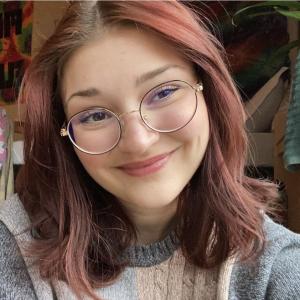Oberlin Blogs
Morgie's the Best: A Saturday at the Morgan Conservatory
February 25, 2010
Ma'ayan Plaut ’10
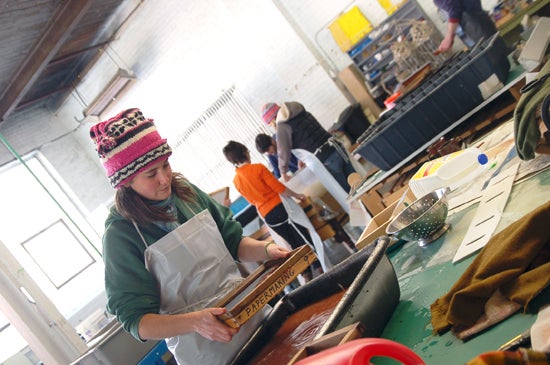
This is what school looks like. Love it.
I guess every semester I end up writing about one class on one particular day in detail: Storytelling ExCo, Pipo's photography class, the practicum in journalism, Oberlin History as American History, and today, Cinema Practicum in Media Literacy and Pedagogy.
I won't go into too much detail explaining about the class's mission and goals, because I touched on these things in my standard semester class explanations and you can also check out our website (which includes a full syllabus and lots of videos!) for more information about that. All you need to know for this post is that cinema studies does not automatically mean movies, and media is not a single type of sensual presentation of information, but rather is a bridge between two things to foster understanding and connections.
This class is made up of a fabulous mix of people that use media and education in a number of ways (again, our website has full biographies and our personal backgrounds in education and media), and even we underestimated the number of things that fall under the title of "media." For one of our first exercises in media education, we took a class field trip. I love field trips.
Rian, one of our two fabulous instructors for this class, is married to a wonderful Italian named Claudio, who is the educational outreach coordinator for the Morgan Art of Papermaking Conservatory, located in a converted warehouse in a rather abandoned industrial district in Cleveland. At 9am Saturday morning, nine students (and Rian and Claudio's son Arturo) piled into three cars with Claudio, Rian, and Geoff at the wheels. It was chilly, but I was still in the mindset of Winter Term, when we got up every Saturday morning to start the drive to Cleveland at 9am for a West Side Market/Korean Seoul Market/Trader Joe's food run. Before we left, Rian mentioned that we might stop by West Side Market for lunch. I immediately perked up (this is saying a lot for a brisk Saturday morning) and started gushing about West Side.
I was in a car with Geoff, Justin (a second year from New York), and Jessye (a senior from the Boston area) with whom we talked about penguins, Roman Polanski, Spain, and Hawaii while tailing Rian to inner Cleveland. Upon arriving at the Morgan Conservatory, we signed in, took a brief tour of the gallery part of the facility (they have printing presses and all these different fonts and soon they'll have a silk screening area too!) before getting an informative crash course from Claudio, with help from Bruce and Tom.

The Morgan Conservatory from the outside. You'd never guess the wonders inside from this outside location.

We got to the Morgan at a perfect morning time when light was streaming into all the windows. So pretty.
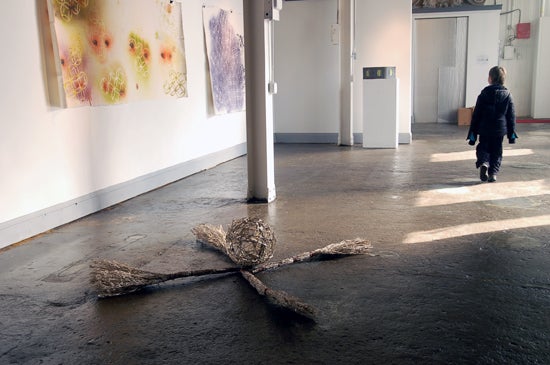
Rian's son Arturo wandered the gallery space like he owned the place. Rightfully so, because his mom has pieces there and his dad works there.


We also toured the learning spaces for printing, printing presses, and other paper-based arts.

There were all these pieces up around the space as well, rethinking what paper means in the art world. This sculpture suspended in the air was a great example of this.

I loved their giving levels poster as well, which names each level of donation with various kinds of paper.
I'll give you as much of the crash course in papermaking as I can; I took a fair amount of photos which should cover most of it. Just imagine that it's 51 degrees inside, you're wearing a warm hat, that your shoes are soaked through, your shirt sleeves are damp, there's a stiff plastic apron slick with water and paper pulp around your neck that you keep on stepping on because you're too short (or maybe that was just a problem for me), and some classic soul and R&B (mainly Bill Withers) interchanged with Pink Martini playing in the background.


Claudio and Tom set up the pulp buckets for a paper-making demonstration.

We were shown a variety of frames on which one could make paper, including a huge frame, handmade out of tiny wire.

Ever wonder what a watermark actually is? It's an intricate piece that will imprint onto the paper, much like this on on the huge frame seen above.

We also looked at these Japanese papermaking frames, which looked exactly like sushi mats!

The process: The wire frame (the frame is called a deckle) has a border that fits on top of it. These two pieces either interlock or are held in place by the force of our hands.

You then agitate the pulp in the water and pull the screen through it.

As soon as you pull through, you pull up, keeping the frame level, which will make for a flat sheet of paper.

You then let the pulp drain out some of the water, usually perched on the side of the tub.

You should also take off the frame and allow the paper to settle and drain more easily.

If for some reason your paper isn't flat or even or it has holes in it, you can "kiss" the screen onto the water and the surface tension will pull the pulp off and it can be reincorporated into the pulp slurry.

Once the paper has had some water drained from it, you roll it off the frame (called couching) onto a pile of dry felt called the post (we were using army blankets).
Once it's on the felt, you can do a million things to it, or leave it plain, and then cover it with another layer of felt so more paper can be put on top of it. Once these stacks are thick, the post is moved to a press that exerts 6 tons of pressure on the whole pile, which squeezes out a great deal of the water.
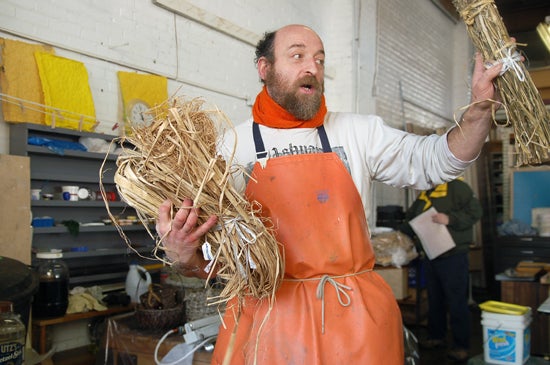
Claudio also showed us the raw fibers before they are soaked and pulverized, including okra, kozo, mulberry, and other fibers.

Claudio also showed us many different kinds of frames, and as this was a learning experience for all of us, there were cameras and videos all around.

We also got to see many different kinds of paper that had been made by students the previous week. This kind of paper has something called an "inclusion," which basically means that there are pieces of whole objects in the pulp, like flowers or leaves. We went a bit crazy with inclusions on Saturday.

These are some of the finished pieces from the students that visited the Morgan last week. We won't be getting our paper for another week, probably.

This dark brown water is the pulp that has the inclusions in it. There were leaves and seed pods and several kinds of flower petals.


We also got a tour of the outside of the warehouse, where they are growing mulberry trees for future papermaking.

A sneak peak of some of our paper... this is still damp and headed for the dry box!
Most of the day was spent covered in water with goose pimples on every part of exposed skin. I swear, I wore my hat more today than I ever have in a 12-hour period, plus three shirts and a sweatshirt and a scarf underneath that. I was still freezing. We were dunking our hands in and out of frigid water in a pretty cold room, and our saving grace was Bruce, who kept on putting out buckets of hot water so we could dunk our poor stiff hands between paper makings. When we filled out a survey of our experience at the Morgan, I wrote in the comment box that I can't feel or control my fingers as I wrote this sentence and I couldn't be more happy about it. As Claudio told us before we got to the Morgan, our savior would be Bruce. Thank you, Bruce.
After learning the basics, all the Morgan staff who were there started having fun with us, pulling out different kinds of paper pulp, molds, and stencils. After lunch, they started dying some of the white pulp that was already out with a variety of colors. We started moving away from the standard rectangles and started layering different shapes, sizes, colors, and textures of paper pieces on top of each other into fabulous creations. Rachel and I spent the last half hour of the workshop peeling the pressed sheets of paper off the felt and laying them on dry pads to head to the drying room later this week. Each layer of felt we peeled off revealed more and more elaborate pieces. What a treasure.
More photos from the Morgan Conservatory visit can be found at my Flickr.
Similar Blog Entries

The New Bass on the Block
April 25, 2025
I decided to come to Oberlin because I wanted more music in my life. I ended up singing bass in the Obertones, Oberlin's only men's and non-binary a cappella group. I regret nothing.
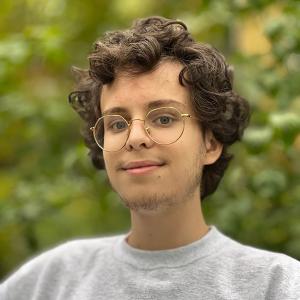
Managing an Oberlin Workload
April 25, 2025
All you need to know about the transition from high school to college course work.
